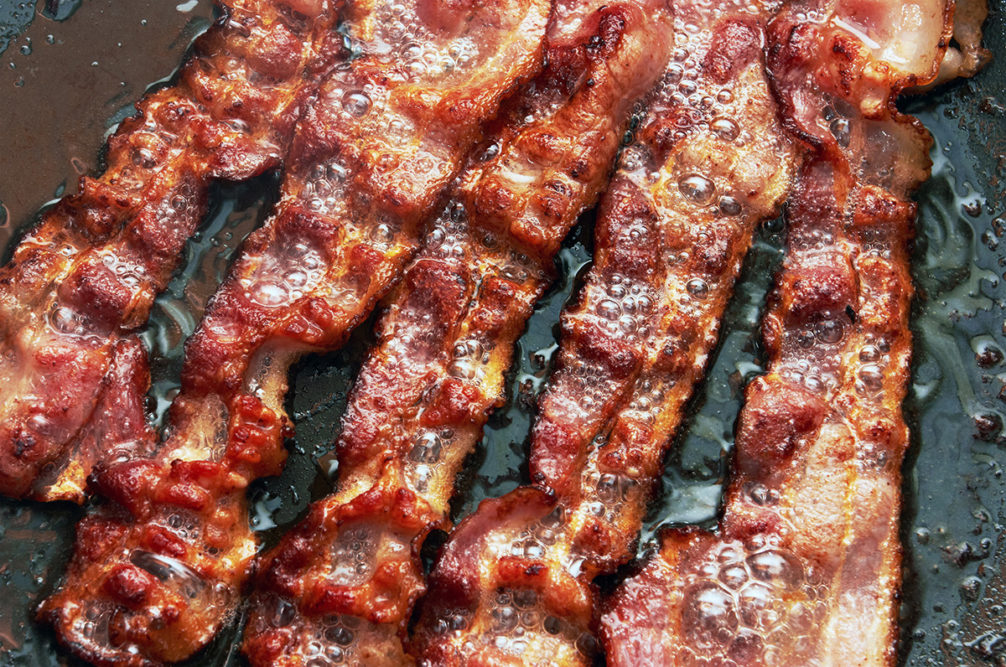Tried and true, bacon boasts another year capturing consumers’ hearts. The beloved cut of meat holds the top spot as the top-selling processed protein, according to data from IRI.
Over the past year, bacon has generated $6.3 billion in sales in the United States. This total is only down 1.3% from last year, which IRI consultant Amanda Evans said is good considering the high rate of inflation at 5.5%. Sales volume decreased slightly by 6.5% to nearly 1 billion tonnes. Experts are not overly concerned by the declining volume, as it is to be expected givent recent economic pressures.
“This is one category consumers are not giving up, which is great to see,” Evans said.
Consumers are especially not giving up on pork-based bacon products. This subcategory continues to dominate far beyond any other bacon protein option.
“The majority of the proteins we’re going to see is pork bacon. That has definitely retained its spot as being king,” Evans noted. “That makes it about 94% of the category, with turkey being that second-most common one at about 5% of the category. Then we do have some smaller options — such as plant-based, beef, chicken — we’ve seen come into the category, but those haven’t been able to make quite the impact that pork or turkey bacon has made up.”
Despite the small share turkey holds in the bacon category, it has seen a positive year in terms of dollar sales, up 5.5% from the previous year. However, much of that increase is attributed to high price inflation, Evans explained. Where pork price inflation is up about 4.5%, turkey price inflation is up about 23%.
“Turkey has had quite a bit of increase in price, and that’s due to inflation within commodities that are super high right now, the tight labor market impact of this, and then the big thing that impacted them was avian influenza this summer, where the industry lost so many birds that it really impacted and disrupted the supply chain,” she said.
Breakfast champ
Bacon has long been a staple in the breakfast category, and it continues to perform strongest in that daypart. Evans noted that consumers commonly purchase bacon with known breakfast items such as hash browns, English muffins, waffle batter and pancake batter, suggesting its strong association as a breakfast item.
In comparison to other breakfast proteins, bacon performs similar to products like breakfast sausage and chorizo. However, it outpaces them substantially, Evans said. While bacon sales total $6.3 billion, sausage sales total about $2.2 billion.
Evans said to watch out for sausage, though, considering its cheaper price per pound during a time when consumers are looking for ways to stretch their dollar. Breakfast sausage costs around $4.77 per lb, while bacon is about $6.62 per lb.
While holding fast to its breakfast roots, bacon demonstrates room for growth into other dayparts as an ingredient component in dishes like pasta, salads and burgers.
“Bacon has definitely figured out breakfast, but there’s still a lot more opportunity for it to become part of the entire day occasion,” Evans said.
Bacon innovations
The area to watch for more diversification and distinction within the bacon category is through claims, according to Evans. Many meat products have increasingly been making natural, sustainability and animal welfare claims to appeal more to consumers. Bacon, however, has yet to fully immerse itself in this trending marketing strategy.
“[Animal welfare claims and sustainability claims] have a lot more opportunity to continue to grow as consumers kind of want more transparency with where their protein products are coming from,” Evans said.
Aside from packaging claims, bacon is distinguishing itself through new flavor innovations. A few unique flavor offerings this past year include maple, maplewood, pecanwood, double smoked and no sugar. Evans believes flavor will be key to capturing consumers’ interest in coming years, allowing bacon to expand its presence. Flavor can also be a tool to target specific consumer groups. For example, younger generations flock more toward flavors like maplewood.
Anne-Marie Roerink, principal at 210 Analytics, echoed Evans, saying many bacon innovations revolve around flavor. Retailers are experimenting with craft bacons, testing out limited-time flavors, thicker cuts and cubed bacon, she said.
“Bacon remains a really fun space for experimentation and has also proven to bring that premium touch that can help drive incrementality,” Roerink said. “Think about bacon-wrapped asparagus sold out of the meat case or bacon-wrapped turkey that suddenly premiumizes the cut.”

